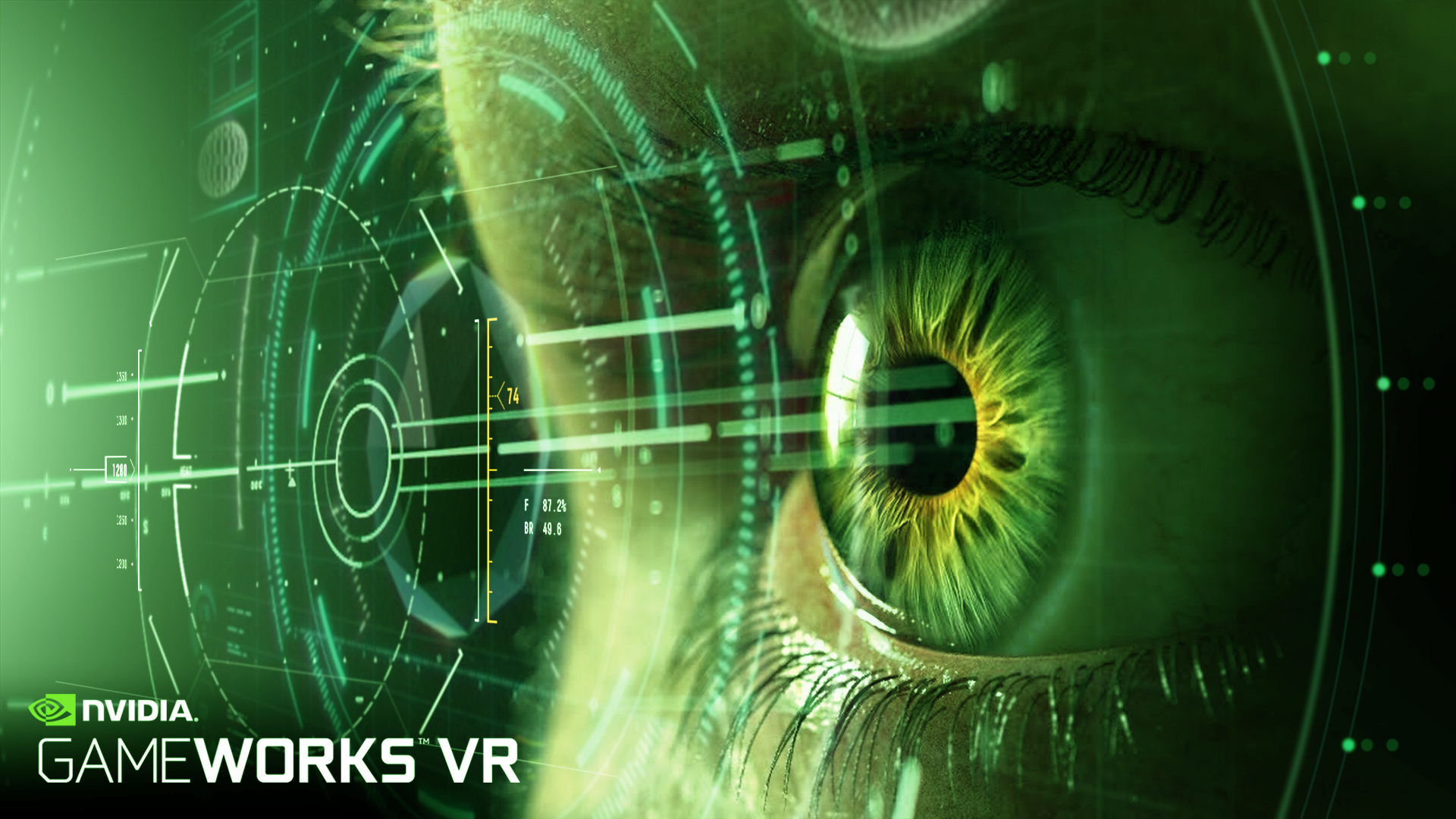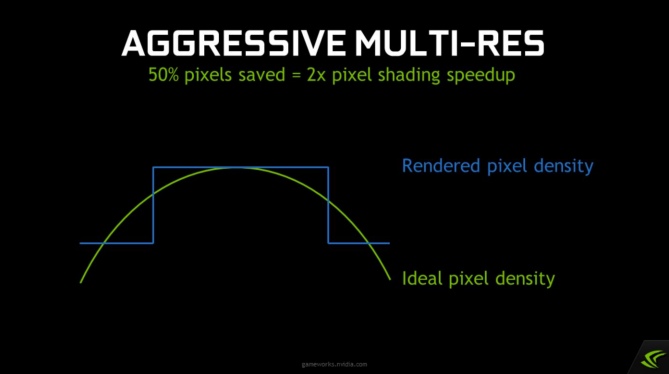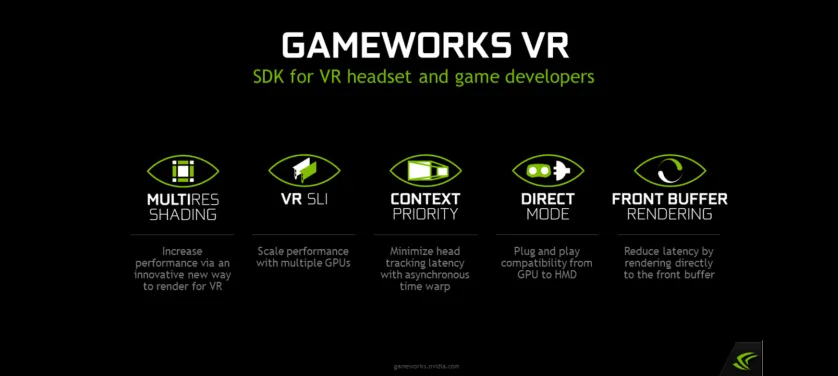Now that NVIDIA transitioned their GameWorks SDK from Alpha to Beta, we interviewed their General Manager, Jason Paul, to find out more about what their platform can bring to the VR developer community. Jason Paul has been working with NVIDIA since 2003.

Jason’s helped bring to market NVIDIA’s latest GeForce GPUs including GeForce 6600, 7600, 7900, 8800, GTX 200, GTX 400, GTX 500 & GTX 600.
As of 2012, he manages the development of emerging products and technologies spanning SHIELD portable, virtual reality, gaming software, and game streaming. On a side note, Jason holds an MBA from Stanford University and a BA from UCLA.
In the following questions, we gain insights into what the SDK can do:
Q: Can you explain to our readers what GameWorks VR is?
A: GameWorks VR is our Software Development Kit (SDK) for virtual reality developers. It is a comprehensive set of APIs, libraries, and new features that enable headset and game developers to deliver amazing VR experiences. The main components of GameWorks VR are:A: GameWorks VR is our Software Development Kit (SDK) for virtual reality developers. It is a comprehensive set of APIs, libraries, and new features that enable headset and game developers to deliver amazing VR experiences. The main components of GameWorks VR are:
VR SLI—provides increased performance for virtual reality apps where multiple GPUs can be assigned a specific eye to dramatically accelerate stereo rendering. With the GPU affinity API, VR SLI allows scaling for systems with >2 GPUs.
Multi-Res Shading—an innovative new rendering technique for VR whereby each part of an image is rendered at a resolution that better matches the pixel density of the warped image. Multi-Res Shading uses Maxwell’s multi- projection architecture to render multiple scaled viewports in a single pass, delivering substantial performance improvements.
Context Priority—provides headset developers with control over GPU scheduling to support advanced virtual reality features such as asynchronous time warp, which cuts latency and quickly adjusts images as gamers move their heads, without the need to re-render a new frame.
Direct Mode—the NVIDIA driver treats VR headsets as head mounted displays accessible only to VR applications, rather than a typical Windows monitor that your PC shows up on, providing better plug and play support and compatibility for VR headsets.
Front Render Buffering—enables the GPU to render directly to the front buffer to reduce latency.
Q: With GameWorks VR moving from alpha to beta, what changes and what is new?
A: Since our alpha release in May, we’ve received a lot of great feedback from both app and game developers as well as headset developers. We’ve polished things up by incorporating their feedback and fixing open bugs. With the alpha build, only developers with NDAs were able to get access. For the beta release, we’re opening up the game and app developer SDK to any developer that signs up for our GameWorks developer program. Free download. No NDA. Headset developers will still need to be under NDA. Finally, GameWorks VR is now supported by our publicly released Game Ready drivers. Gamers with the latest drivers will be able to receive the benefits of GameWorks VR with supporting applications and headsets.
Q: When will GameWorks VR be available to developers?
A: Registered developers can download the NVIDIA GameWorks VR beta SDK now from our GameWorks VR developer site.

Q: What is the key difference in working with developers for virtual reality over traditional game development?
A: How NVIDIA works with VR vs. traditional developers isn’t all that different. The key difference is that VR games can be much more sensitive to performance, so graphics profiling and optimization become that much more important to delivering the right experience.
Q: What GameWorks VR features are for HMD vs. Game developers?
A: Context Priority, Direct Mode, and Front Render Buffering are for HMD guys. Multi-Res Shading and VR SLI are for the game and app developers.
Q: What is the biggest advantage to using an NVIDIA GPU for VR?
A: It’s tough to call out just one. But if forced to pick, I would say our Game Ready drivers. NVIDIA invests an enormous about of time working closely with developers to make sure games work out of the box with our drivers, on the day the game ships. This is incredibly important for VR as the slightest stutter or performance dip can ruin the experience. Our track record of delivering launch day drivers for every major game release will be a big difference for VR games. Of course, having the industry’s fastest GPUs and unique VR features like multi-res shading are a nice bonus too!
Q: NVIDIA’s first SDK was called VR Direct? What happened to that?
A: GameWorks VR is the new name for VR Direct and offers expanded features and capabilities. As we added more features to our VR SDK, it made sense to consolidate the brand name with our overall GameWorks suite of developer tool and libraries.
Q: Is NVIDIA working with Envelop VR?
A: NVIDIA believes VR is the next major platform in computing, and as such, is talking to a broad range of VR software and hardware players including the guys at Envelop.
Q: What is NVIDIA doing to reach 90 fps goal for both the Vive and CV1?
A: We are building the industry’s fastest GPUs optimized for VR with our GeForce GTX 900 GPUs. We are working to provide optimized game settings for VR games with GeForce Experience so that in-game graphics settings are automatically configured to maintain 90 FPS for a user’s specific hardware configuration. And we are building GameWorks VR SDK support for features like VR SLI and NVIDIA Multi-Res Shading to help developers get more performance from the graphics hardware.
Q: Is there going to be an advantage for CV1 because NVIDIA has worked with it longer?
A: NVIDIA has been working closely with the major VR headset manufacturers including Oculus and HTC/Valve. Gamers can trust that both headsets will run great on GeForce GTX.
Q: In your internal tests, what are the most GPUs have ya’ll attempted to run at the same time?
A: We’ve tested up to 4-way SLI on Titan X. That’s a lot of horsepower!
Q: Multi Res Shading (MRS) sounds like a great way to shorten rendering times. Is MRS ever noticeable to the user?
A: When done correctly, no. In our side by side tests, where users were looking for differences, it’s effectively undetectable by eye when we reduce the workload by 30%. And once in a while people with a very trained eye can see it at 50%. Ultimately this is a powerful tool we put in the hands of the developer, and allow them to make the right tradeoff for their game.

Q: Last year Oculus introduced Direct Mode into their windows drivers for the DK2. What are the differences between the GameWorks VR Direct Mode and the Direct Mode in the Oculus drivers?
A: We have developed the new Direct Mode support in collaboration with Oculus and it’s designed to work with their upcoming 0.7 SDK. Rather than inserting VR functionality between the OS and the GeForce driver, headset awareness is added directly to the GeForce driver. As a result, the new Direct Mode avoids many of the latency challenges of Extended Mode and significantly improves compatibility.
Q: It is my understanding that front buffer rendering was also possible with the Oculus Direct Mode. Does the front buffer rendering support from NVIDIA have any more added advantages?
A: Similar to Direct Mode, the new implementation is native to the GeForce driver and thus offers a more robust experience.
Q: With GameWorks VR entering the beta phase, will developers still have to apply to get access or will it be available for everyone?
A: The GameWorks VR Beta SDK comes in 2 flavors:
1) An SDK for game and application developers, including VR SLI and Multi-Res Shading
2) An SDK for headset developers, including Context Priority, Direct Mode, and Front Buffer Rendering
For the beta release, we’re opening up the SDK for game and app developers. Developers simply sign up for our GameWorks developer program to access the SDK. No NDA. For the SDK for headset developers, HMD developers will still need to be under NDA.
Q: When will Unity and Unreal Engine developers have access to the GameWorks VR features?
A: We are working closely with the major engine developers to get GameWorks VR integrated. We should have some updates here very soon!
Q: What is the minimum NVIDIA card required by GameWorks VR?
A: NVIDIA Multi-Res Shading requires Maxwell cards, so GeForce 900 series and up. The rest of GameWorks VR is supported on GeForce 600 series (Kepler) GPUs and up.
Q: Will users need to install VR-specific drivers to run applications that use the GameWorks VR SDK?
A: No, with today’s announcement our publicly available Game Ready driver supports GameWorks VR.
Q: Do you think we will ever see these features supported on Macs?
A: That one is a question for Apple.


























